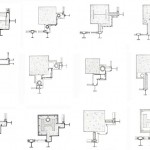Zoroastrianism traditionally conceives death as a temporary triumph of evil over good: rushing into the body, the corpse demon contaminates everything it comes in contact with.
The flesh of a dead body being so unclean it can pollute everything, a set of rules had to be created in order to dispose of the corpse as safely as possible: as the natural elements of earth, air and water are sacred, the corpses were not to be thrown upon the water or interred. Cremation was also forbidden, as fire is the direct -purest- emanation of the divinity.
Hence a complex ritual was developed, in which the corpses would be eventually exposed to birds of prey and thus devoured, in a final act of charity.
After death every division of class and wealth disappeared, for all deceased would be treated equally.
A proper architectural typology was invented solely for the purpose of burial’s ritual: transported in the desert by nasellars (traditional Zoroastrian pallbearers), the bodies of the deceased were then carted onto sandstone, forbidding hills, to be eventually disposed on cylindrical constructions called Towers of Silence.

A Tower of Silence, or Dakhmeh, is a structure laying on the top of a hill, consisting of concentric slabs surrounding a central pit. The bodies were arranged onto four concentric rings: men, outermost, then women and children. Despite the fact the birds of prey needed less than an hour to leave nothing but bones, the remains of the dead were left bleaching on the upper circles no less than a year before the nasellars could come and push the skeletons onto the underlying ossuary pit. Running through sand and coal filters, the disintegrated bones were eventually washed away in the sea.



A guardian traditionally lived near the Tower of Silence, and was the sole person allowed to handle the ceremonial procedures, while relatives of the deceased stayed in a house below, and were forbidden to enter.
Iranian Zoroastrian discontinued this ceremony, and the Dakhmeh were banned in the ’70s; conversely, Parsi modern-day Zoroastrians in Mumbai and Karachi still maintains the tradition of burial by exposure, through the use of their own Towers of Silence.
Further read:
Towers of Silence on Wikipedia
A Sea of Lead, a Sky of Slate
Historical Iranian Sites and People


Julia Maudlin licensed under the Creative Commons Attribution 2.0 Generic license.

Julia Maudlin licensed under the Creative Commons Attribution 2.0 Generic license.

V licensed under the Creative Commons Attribution 2.0 Generic license.




wonder how they feel knowing when they die they get eaten by birds….
Guy: I guess not that different from us knowing we’re gonna be eaten by worms.
Tibetans Buddhists do the same thing, called Sky Burial.
The line that jumped out at me in this article was ” a final act of charity.” Giving bodies to the birds, and thus disposing of the dead flesh, is a charity to the birds, and destroying the death-demon that inhabits the corpse. That’s just my interpretation, I could be totally wrong here.
But the Tibetan context is completely different – Tibet has little suitable land for burial, and not enough fuel for pyres, so disposal-by-vulture is the most practical option. And in Tibetan Buddhism, once the soul is gone, the body’s just an empty shell. The monks doing the burial often laugh and joke while chopping the body up for easier consumption, because the body’s just a piece of rotting meat.
(quote) But the Tibetan context is completely different – (/quote)
Maybe not so different-
According to the Tibetan themselves, their native religion Bonism apparently came from a people living west of them known as the “Tazik”. This could be the Persian Tajiks.
The “ritual of death” custom in Tibet and Mongolia are the same like the Zoroastrian custom, called “Sky burial”. Tibet has an additional custom – the “Air burial”. Many years ago Tibet had also a “water burial” . No Tibetan will eat fish to this day.
One fully has to understand the Zoroastrian Belief to understand and respect their old customs.
The last “good deed” for the Zoroastrians is the more than 4000 year old sky burial according to their prayer “good thoughts, good words, good deeds”.
Thank you for sharing this sacred information.
“After death every division of class and wealth disappeared, for all deceased would be treated equally.”
Beautiful. After all we all stand before God, and all of our bodies decay.
By the way, for everyone who keeps saying buried bodies are eaten by worms, no. Buried bodies are eaten by beetles, not worms. If a body is exhumed, sometimes the maggots (beetle larva) are visible, which caused the myth that worms were eating them.
thanks…………….
i wanted information for my project thankyou so much
GOD ……. DIS IS JUST UN TOLERABLE
THE PEOPLE ARE NOT PIECES OF MEAT DAT D BIRDS OF PREY CAN PREY ON THEY ARE HUMANS
ANYWAYS THANKS AS I NEEDED IT FOR MY PROJECT BUT DUDE ITS JUST AWEFUL
STOP IT MAN FOR GODS SAKE
awsm……………..imformation..like too much
just what i needed for my project………its fabulous!!!!
Although this was without doubt the original intent, this method of burial is much more ecologically sound than any other. What could be better” A system that is devoid of class or status, that is ecologically sound, that conserves land needed for burials and conserves energy that would be needed for CO2 producing cremation!
Very horrible…..and useful information…….very knowledgeble….
bhenchod kya chutiyagiri hai!
I think this is a really beautiful tradition, I’m curious how it developed, Sky burial is a result of their being a lack of land for graves and due to altitude the pace of the decaying body would be too slow and attract vermin… Does this tradition appear out of a similar geographical situation?
IT IS VERY GOOD ……..JUST THE THING NEEDED FOR MY PROJECT……………..ITS AWESOME………:-)…….;-)
Thanks for finally talking about >Towers of Silence: Zoroastrian Architectures for the Ritual
off Death – SOCKS <Liked it!